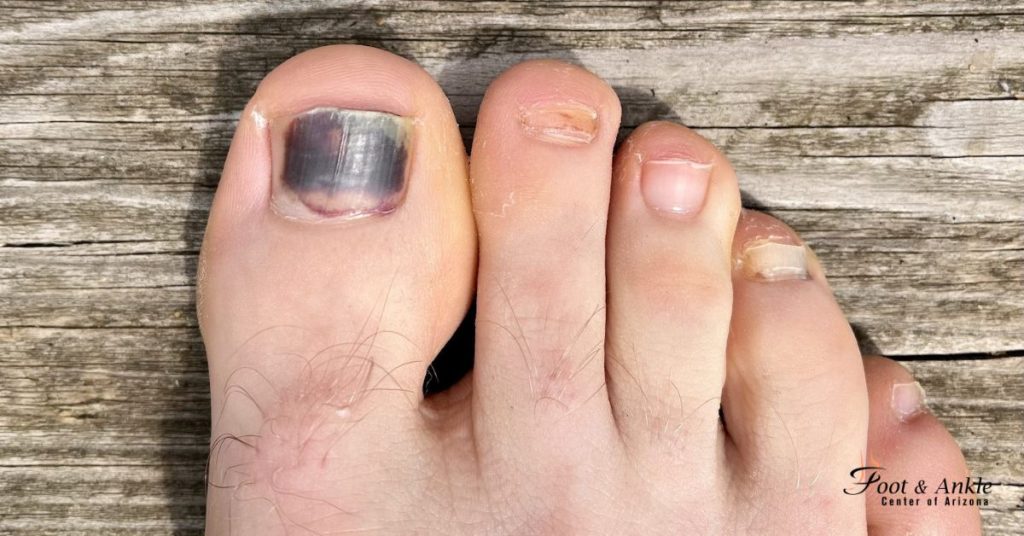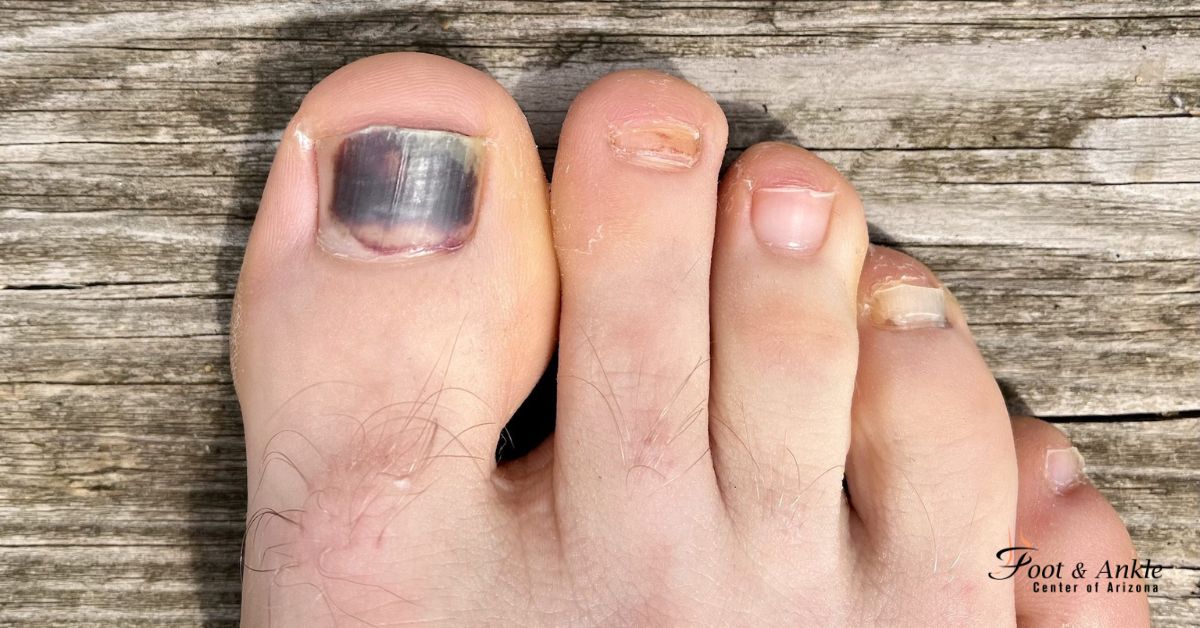Experiencing changes in your toenails can be unsettling. One of the more alarming changes you might notice is your toenails becoming black and thick. At the Foot and Ankle Center of Arizona, Dr. Kris A. DiNucci, DPM, FACFAS, and our team often address these concerns. This article will explore the common causes, treatment options, and preventive measures for black and thick toenails.
Common Causes of Black and Thick Toenails
Trauma
Acute Trauma: A sudden impact or injury to the toe can cause the toenail to turn black and thicken over time. This usually happens when the nail bed bleeds and the blood gets trapped under the nail, causing a subungual hematoma. This can occur from dropping a heavy object on your toe, stubbing your toe, or repetitive pressure from activities like running.
Chronic Trauma: Repeated minor injuries, often due to poorly fitting shoes or repetitive activities like running or hiking, can lead to thickened, discolored nails. This is common among athletes and can be exacerbated by improperly trimmed nails that continuously hit the front of the shoe.
Fungal Infections
Onychomycosis: A fungal infection of the toenail can cause it to become discolored, typically yellow or brown, and thickened. As the infection progresses, the nail can turn black due to the buildup of debris and dead tissue under the nail. Onychomycosis is more common in individuals with a weakened immune system, those with diabetes, and the elderly.
Bacterial Infections
Paronychia: This infection of the nail folds can lead to inflammation, pus formation, and eventually changes in the nail color and texture. Chronic paronychia can cause the nail to become thick and discolored over time.
Underlying Medical Conditions
Psoriasis: This chronic skin condition can also affect the nails, causing them to thicken, become discolored, and develop ridges. Nail psoriasis can lead to a build-up of cells under the nail, causing it to appear black.
Diabetes: Poor circulation and peripheral neuropathy associated with diabetes can lead to changes in the toenails, making them more susceptible to infections and trauma.
Melanoma: A rare but serious cause of a black toenail can be melanoma under the nail. This type of skin cancer can present as a dark streak or spot under the nail and requires immediate medical attention.
Medications and Chemical Exposure
Certain medicinal drugs, like chemotherapy tablets, can motive adjustments in nail color and texture. Exposure to harsh chemical substances or nail polish also can damage the nail, making it thick and discolored.
Diagnosis and Treatment Options
If you notice a black and thick toenail, it is essential to seek professional evaluation to determine the underlying cause. Dr. Kris A. DiNucci, DPM, FACFAS, and our team at the Foot and Ankle Center of Arizona will conduct a thorough examination, which may include:
- Medical History: Understanding any recent trauma, existing medical conditions, and medication use.
- Physical Examination: Assessing the nail and surrounding skin for signs of infection, injury, or other abnormalities.
- Diagnostic Tests: In some cases, a biopsy, fungal culture, or imaging studies may be necessary to confirm the diagnosis.
Treatment Options
- Trauma-Related Black and Thick Toenails
- For acute trauma, draining the subungual hematoma can relieve pressure and pain. In severe cases, removing the damaged nail may be necessary to allow a new, healthy nail to grow.
- For persistent trauma, addressing the underlying purpose is essential. This may involve changing footwear, the use of shielding padding, and adopting proper nail-trimming strategies.
- Fungal Infections
- Topical Antifungals: These can be effective for mild infections but require consistent application over several months.
- Oral Antifungals: For extra intense infections, oral medicinal drugs like terbinafine or itraconazole may be prescribed. These medicines are greater effective however may have aspect effects and require tracking.
- Laser Therapy: A newer treatment option, laser therapy can target and destroy the fungus without affecting the surrounding tissue.
- Bacterial Infections
- Antibiotics: Depending on the severity of the infection, topical or oral antibiotics may be prescribed.
- Drainage: In cases of abscess formation, draining the pus can help relieve symptoms and promote healing.
- Underlying Medical Conditions
- Psoriasis: Managing nail psoriasis involves treating the underlying skin condition. This can include topical treatments, systemic medications, and biologics.
- Diabetes: Proper management of diabetes through blood sugar control, regular foot examinations, and prompt treatment of any infections or injuries is crucial.
- Medications and Chemical Exposure
- Adjusting medications or discontinuing the use of harsh chemicals can help improve nail health. Protective measures, like wearing gloves when handling chemicals, can also be beneficial.
Preventive Measures
Preventing black and thick toenails involves a combination of proper foot care and lifestyle adjustments:
- Footwear
- Wear well-fitting shoes with adequate room for your toes. Avoid high heels and narrow-toed shoes that can cause pressure and trauma to the nails.
- Nail Care
- Trim your toenails straight across and avoid cutting them too short. Use clean, sanitized tools and consider professional nail care if you have difficulty trimming your nails.
- Hygiene
- Keep your feet clean and dry. Change socks regularly and choose moisture-wicking materials to prevent fungal infections.
- Protective Measures
- Use protective footwear for activities that may expose your toes to injury, such as sports or heavy lifting.
- Regular Check-Ups
- Regularly inspect your feet and nails for any changes. If you have diabetes or other risk factors, schedule regular check-ups with a podiatrist to monitor your foot health.
- Healthy Lifestyle
- Maintain a wholesome weight loss plan and workout routine to aid normal foot fitness. Managing underlying health situations, such as diabetes and psoriasis, is essential for stopping complications.
When to Seek Medical Attention
It is important to seek medical attention if you notice any of the following:
- Persistent pain or swelling in the toe.
- Signs of infection, such as redness, warmth, or pus.
- Changes in the nail that do not improve with home care.
- A dark streak or spot under the nail that does not grow out with the nail.
- Thickening or discoloration of multiple nails.
Conclusion
At the Foot and Ankle Center of Arizona, Dr. Kris A. DiNucci, DPM, FACFAS, and our crew are devoted to imparting complete take care of all foot and ankle conditions, such as black and thick toenails. Understanding the underlying causes and searching for well timed remedy can prevent headaches and repair the health of your nails. If you have got concerns approximately your toenails, do no longer hesitate to touch us for an intensive assessment and customized treatment plan. Your foot health is our precedence, and we’re right here to help you each step of the manner.





